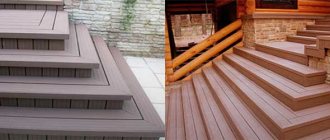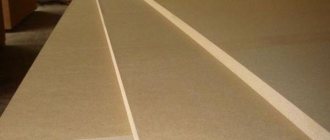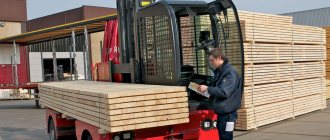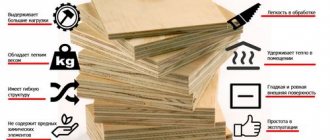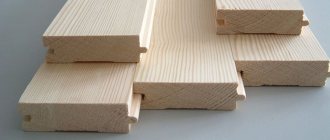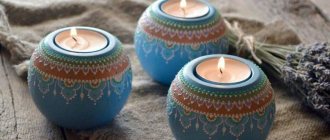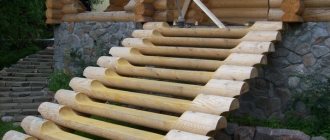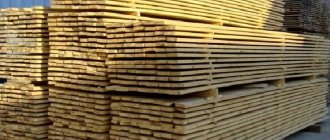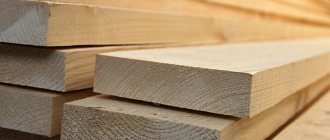Installing a decking board is a rather labor-intensive and complex process, but if you wish, you can do it yourself, even without professional skills.
The first thing that needs to be done is to prepare supports for the frame for laying our boards. The service life of your structure depends on how securely you lay the base and install the frame on it.
There are 3 ways to prepare the flooring for the decking board . The first is on a sand-gravel bed, on a concrete screed, on metal piles and on concrete piles.
In our case, we will consider the easiest and least expensive method, installation on concrete piles. They can be made either under a wooden beam or under the installation of a metal frame.
The material of choice is larch.
Content
- Advantages of larch decking boards
- Two ways to lay boards
- open;
- closed.
- Types of hidden fasteners for decking boards
- Stages of laying larch decking boards
- base;
- board processing;
- frame;
- installation of boards.
- 5 common installation mistakes
- Finally
The terrace at home is a place where you can relax, unwind and spend time with loved ones. On warm summer days, the lives of some city dwellers almost constantly revolve around gardening and greenery. A well-thought-out and decorated terrace provides shelter from the scorching sun, allows you to dine in the fresh air and relax with your favorite book.
If you love nature and want your terrace to be in maximum harmony with the environment, choose larch. It is famous for its excellent resistance to moisture, beautiful warm color and is close in strength to oak, which is why it is chosen by manufacturers for the manufacture of decking boards.
Foundation preparation
If you plan to lay the boards outdoors, you will need to use a vibrating plate that compacts the soil well. After this, the surface is covered with gravel; It will take about 10 cm, pour 5 cm of sand on top and compact it tightly again. After this, it is necessary to use reinforced mesh and build a concrete foundation. You can make a slab foundation using support logs, often using a columnar foundation or using screw piles.
Advice from an experienced craftsman: in order to prevent moisture from retaining on the terrace, the board should be laid with a slight slope. For this purpose, special plastic devices are used.
Advantages of larch decking boards
Thanks to the properties inherent in nature, lumber is subsequently used in the open air and does not rot, warp, or crack. In addition, he:
- easy to install;
- has a wide range of applications from arranging verandas and terraces to constructing garden paths;
- divided into varieties. Everyone will select material according to their budget;
- lasts more than 5 years with proper care;
- flexible and elastic;
- beautiful, with a uniform texture, a pronounced pattern and no color differences.
Larch decking boards are the most popular in our country. The raw materials for its production grow within walking distance. It is not complicated or labor-intensive to process.
This lumber can be smooth or “corduroy” with longitudinal grooves along its entire length. The first option is popular when it comes to creating various types of fences. It does not collect dust, dirt, particles of plants and leaves. However, it is more prone to scratches, so it needs regular thorough cleaning, preferably with a high-pressure cleaner.
The second is good for decking, garden paths, and finishing around outdoor pools. The corrugated top layer drains excess water during rains and protects the wood from damage. People can walk on this surface without fear of slipping.
Operation and care
It is very simple to care for such a coating; for this, a brush is used, the movements of which are carried out in the direction of laying the boards. Domestic sinks can be used, but the water pressure should not exceed 80 bar. Do not use solvents, aggressive detergents or stain removers.
It is necessary to ensure that the gaps are clean, otherwise moss may appear in them. To prevent the development of moss, the surface must be cleaned regularly. To ensure that the flooring wears evenly, it is recommended to periodically rearrange the objects on it.
If greasy stains appear, they must be removed immediately; household degreasers are used for this. When a stain appears, it can be sanded, and after a while, the discolored area will become equal to the color of the main coating. To remove scratches, you can use a metal brush, but before doing this, the boards must be well wetted; over time, the color of the treated area will even out.
Two ways to lay boards
- Open. It involves fixing larch decking boards to the base with nails or screws. In this case, the fastener comes into contact with water, snow, and sun, undergoing corrosion, and then weakens. Unfortunately, the appearance of this fastener is not the most aesthetically pleasing due to rust stains around the hardware heads. Therefore, choose stainless steel screws and nails, and close the resulting holes with plugs.
- Closed. Hidden installation of decking boards on any surface is possible. This is very convenient because of the invisible fasteners, the size of which directly depends on the thickness of the board being laid. Due to the installation of lumber outdoors, the fasteners must have a high-quality anti-corrosion coating.
Protecting the coating from external factors
Although larch has high wear resistance classes, additional protection will not harm the parquet board. Using specialized varnishes and oils, a protective film is formed on the surface of the terrace. These protective coatings are selected depending on the operating conditions of the terrace.
Varnishing decking boards
Types of hidden fasteners for decking boards
Hidden fasteners are divided into three groups:
- thorny. Allows installation without grooves in the ends. These include the “Cobra”, “Cat”, and “Key” mounts.
- "snake". A good option for boards laid at an angle.
- grooved “Bridge” and “Crab” are needed for a straight profile at the ends.
Let's consider the most popular types of fasteners in detail.
"Key"
Developed in England, it quickly gained popularity among us. It is used for boards thicker than 18 mm and resembles a key in appearance. Made from stainless steel with a durable rib that ensures fastening stability.
"GVOZDECK"
This type of fastener combines the advantages of self-tapping screws and nails. Suitable for boards of any thickness, made of stainless steel. Does not rust. To work with it you need a hammer, a screwdriver and a screwdriver.
GVOZDECK does not interfere with the process of re-processing the surface in case of damage. The coating is easy to sand and coat with protective compounds. In addition, the advantages of fasteners include:
- high degree of connection without weakening throughout the entire period of operation;
- does not slip out of the grooves;
- not afraid of the sun;
- suitable for any type of wood;
- ensuring uniform load distribution over the surface;
- reduction of time spent on installation due to easy work with fasteners;
- one element attracts two boards to the joist at the same time.
Advantages
Larch deck boards for terraces have undoubted advantages compared to other types of decking. The material has:
- Low cost, making coverage affordable for many property owners;
- Spectacular appearance that can decorate any interior;
- Corrugated texture of the front surface, thanks to which the material does not slip;
- Standard dimensions for easy installation;
- Durable surface that does not require careful maintenance (accumulated dirt is easily washed off with water);
- Resistance to rotting and fungus formation;
- Low fire hazard.
"Snake"
If the deck boards are laid at an angle, craftsmen choose this particular fastener. It belongs to the hidden type, the flooring is even, strong and smooth. “Snake” is not afraid of moisture due to the galvanized top layer. It looks like a small plate with holes for fixing. The main hole is located 10 mm further from the edge, the rest are closer to the center.
Thanks to the “Snake” modifications, the correct laying of larch decking boards can be done with or without a gap. The difference in fastenings lies in a special stopper. As a rule, “Snake” is chosen taking into account the width of the board:
- for boards with a width of 70 to 110 mm - Snake 145;
- from 100 to 150 mm - Snake 190;
- more than 140 mm - Snake 70. In this case, two Snakes are mounted at the same fastening point, but on different sides of the board. They are, as it were, “separated”, then such a one-piece Snake of two products better tightens the board and prevents warping;
- For a restive board, the Snake-Channel is suitable.
The Snake Boat can withstand heavy mechanical and wind loads equal to 450 kg/m2. It is good for installing decking boards made of heavy wood. Masters advise choosing the Mst snake for places with high humidity.
Clips/clasps
The advantage of this fastener is that it maintains the integrity of the board. Corners or clips are installed at the edges. Using one product, only one board is pressed. The clip is mounted to the joists using self-tapping screws. The production of this fastener, like others, is made of stainless steel to avoid corrosion from water and moisture.
Hidden tenon fasteners
Suitable for budget larch decking boards. Attached to the joists on the already laid flooring. Each subsequent board is mounted on a tenon.
Features of facade finishing
Terrace boards are purchased with enviable frequency in order to beautifully decorate facades. The facing material in question is installed on the specified bases according to a specific pattern. To fix the boards on the facade, you can call specialists, or you can do all the work yourself. Let's look at step-by-step instructions on how to correctly mount the board in question on a façade base.
- This type of decking is also called facade. The starting strip is attached to the sheathing, pre-assembled on the facade, using self-tapping screws directly along the planes located outside. After this, the fastener will need to be installed in the end part of the strip. This should be done so that the second bent plane of the material begins to abut against the plane of the lath.
- Next, using a nail, the fastening element is attached directly to the end part of the facade strip.
- Another nail needs to be driven into the sheathing.
- The second board must be installed on top of the first, pressing it to the base - the sheathing.
- The upper bar is driven into the tenon of the fastener. To do this, it is best to use a mallet and a small block of wood. Impacts should be made as close as possible to the areas where the frame slats are located.
All façade boards are installed using this principle. The diagram is simple and clear. In most cases, a similar installation method is used for ventilated facades. In the gap that remains between the cladding and the wall, a small free space is always left. From it, raw air vapors that penetrate into the premises of the building are removed to the top, without remaining on the wooden facing materials.
Stages of laying larch decking boards
Despite the hardness of larch, installing decking boards is not that difficult if you know the basic information about building decks.
Base
The first question that arises before starting work concerns the location of the terrace. If this is a prepared base made of logs, the craftsmen immediately begin installation. Otherwise, work begins with clearing the area by removing the organic layer of soil and spreading gravel. The base for installing the decking board must be strong and stable. It is important that water passes through it and is absorbed into the ground.
The second question is the shape of the terrace. The size and location in relation to the house and site should be agreed upon. At this stage, the location of the boards in relation to the door is chosen, parallel or perpendicular, observing the slope for water drainage.
The third is the height of the flooring, taking into account the height of doorways, windows, etc. The minimum height of the structure is 7 cm (board + joists). The height of the terrace determines
Board processing
Before starting installation work, the deck boards and base should be treated with oil. They are available in a variety of colors so you can choose one that suits your exterior.
Products must be painted on all 4 sides and allowed to dry. Then apply a second coat of oil to the joists, bottoms and sides of the deck. The second layer is applied on top of the board after installation work is completed.
Wax-based impregnation will help protect the ends from cracking, and an antiseptic will make them unattractive to insects and prevent the development of mold.
Frame
To make the structure as stable and level as possible, I install the logs on the base using adjustable supports. Craftsmen recommend using timber as a lag, the humidity of which does not exceed 25%. It is better when it is also made of larch.
You cannot install logs on the ground, otherwise they will quickly become unusable due to lack of ventilation. To do this, leave a gap of 7-8 cm; you cannot fill it with anything. The products themselves are mounted at a distance of 30-40 cm from each other for better load distribution.
Installation of boards
The most important step in installing a larch decking board is laying the first element. It is placed on supports at a distance of 2 cm from the wall and fixed with self-tapping screws. Then install the selected fastener. For example, if it is a GVOZDECK Twin, then first it is attached to the board, and then to the joist. The next board is laid at a distance of 4-7 mm and driven into the fastener tenons with a rubber hammer, fixing it. At the end, the side strips are installed.
In some cases, larch decking boards are laid on a metal base. Thanks to the good flexibility of the metal, craftsmen are able to create bases of different shapes and sizes, while maintaining strength and durability. Laying lumber on such a base is also easy. Such terraces can be found in summer cafes, on piers, beaches, and dance floors.
Protective impregnations
Remember that no matter what the wood is, sooner or later it will begin to crack, rot and deform under the influence of natural phenomena. Special compounds will help protect it from rapid deterioration: oils, varnishes, paints, for example, the famous brand Pinotex .
Varnishes are not recommended. They are not durable, they will last a year at most. Then you will have to re-varnish the wood, wasting effort, time and money.
Oil formulations are more in demand. They penetrate deeply into the material and are applied very simply and quickly with a brush or roller. The risk of defects is reduced to zero. Oils last much longer, maintaining their original qualities and protective properties. There is a wide range of products on the market, so choosing is easy. Oil mixtures protect floorboards from ultraviolet radiation, water, snow, temperature changes and other factors that can shorten their service life. In addition, there are tinting compounds that allow you to slightly change the color of the terrace covering.
Paints also protect wood well and are available in a large selection. They have the proper elasticity, strength and durability, so they do not crack during seasonal expansion of the floorboards, do not flake or peel.
Which composition to choose - decide, taking into account financial capabilities and requirements for the final result. Buy products from well-known brands, being confident in their quality.
Varieties
Wood grades and classes
In addition, floorboard classes may belong to a specific grade:
- Grade A, of impeccable quality. The surface of the coating does not contain knots, roughness, or dark spots. The smooth surface of the material does not require additional processing;
- Grade B allows the presence of a couple of well-processed knots on the surface of the panel. At the same time, the floorboard has a perfectly smooth surface;
- Grade C is a low quality coating. The surface contains a large number of knots. The quality of the slab is regulated by GOST, which prohibits too large or fallen knots;
- Grade AB, represented by absolutely smooth slabs. The material may simply differ in color, that is, in one batch there are boards darker or lighter than the main shade. The AB variety is in demand due to its good quality and average cost.
Unfinished floorboards

